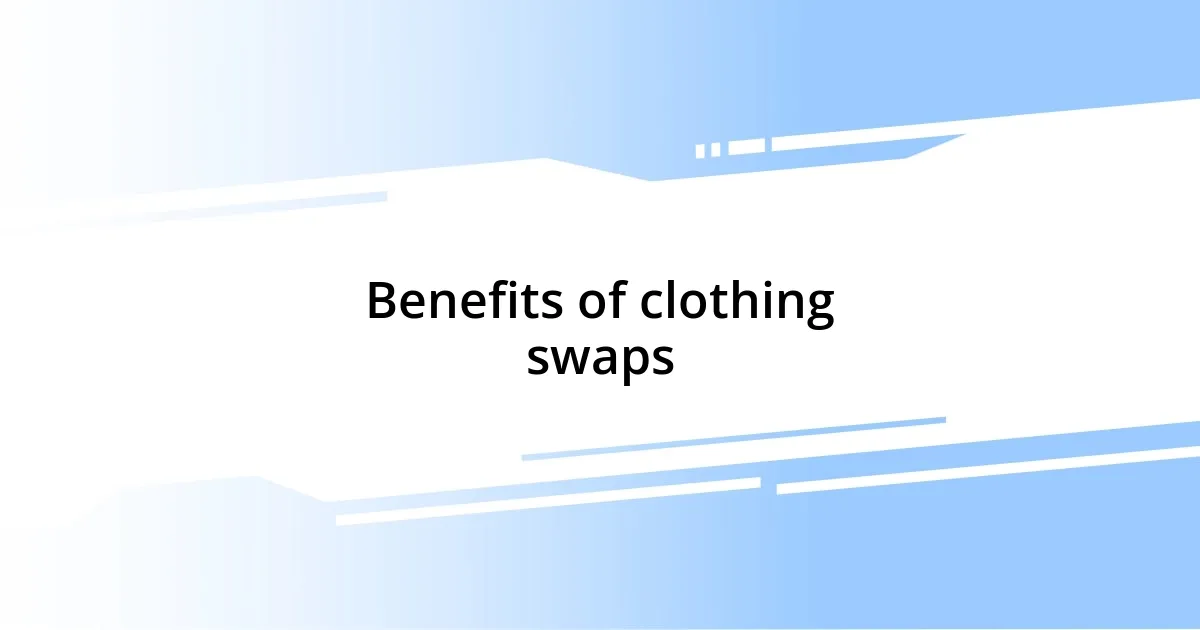Key takeaways:
- Clothing swaps promote sustainability by reducing waste and carbon footprints through the reuse of garments.
- They foster community and personal connections, enriching the experience beyond just exchanging clothes.
- Preparation and organization enhance swap success, including setting guidelines and maintaining item quality.
- Etiquette in swaps is crucial; participants should be respectful and considerate of others and the items shared.

Understanding clothing swaps
Clothing swaps are a fun and sustainable way to refresh your wardrobe without spending a dime. I’ll never forget the thrill I felt at my first swap event; exchanging my unworn clothes for someone else’s fabulous finds was like a treasure hunt. Have you ever experienced the joy of discovering a piece that feels like it was made just for you?
At their core, clothing swaps promote community and creativity. Sharing clothes not only allows us to find unique items but also encourages conversations about style and personal expression. I remember chatting with a fellow swappee who had a unique perspective on fashion; her playful insights made me rethink the way I approached my own wardrobe.
Participating in a clothing swap can also feel like an emotional release. When I let go of pieces I no longer wore, I felt lighter—not just in my closet but in my mind. Isn’t it interesting how what we wear often reflects our personal journey? Embracing this cyclical nature of clothing can deepen our connection to the items we choose to keep or trade away.

Benefits of clothing swaps
Clothing swaps come with a variety of benefits, but one standout advantage is their positive impact on the environment. When we exchange clothes instead of buying new ones, we’re actively reducing waste and minimizing our carbon footprint. I still remember the satisfaction I felt after realizing that the lovely dress I picked up at a swap saved it from ending up in a landfill. It’s a small victory, but those small steps collectively make a significant difference in promoting sustainable living.
Another advantage is the community-building aspect of clothing swaps. It’s not just about the clothes; it’s about connecting with others who share similar interests in fashion and sustainability. I’ve forged delightful friendships at swap events simply by bonding over a mutual love for vintage clothing. Sharing stories while we sift through piles of garments creates a sense of camaraderie that truly enriches the experience.
Lastly, clothing swaps provide a unique opportunity for self-expression. When I stepped into a swap, I discovered pieces that pushed me out of my comfort zone. I once found a bold, patterned shirt that I would never have bought on my own, but it ended up becoming a conversation starter and a favorite in my wardrobe. When we allow ourselves to explore new styles through swaps, we can uncover a side of ourselves that may have been hidden away.
| Benefit | Description |
|---|---|
| Environmental impact | Reduces waste and carbon footprint by promoting reuse of clothing. |
| Community building | Facilitates connections with others who share similar interests and values. |
| Self-expression | Encourages exploration of new styles and personal wardrobe diversity. |

Tips for successful clothing swaps
When it comes to successful clothing swaps, preparation makes all the difference. I recall a swap I attended where I brought only a few items, and I regretted not sorting through my closet more thoroughly beforehand. It’s crucial to pick pieces that are in good condition and reflect your personal style—this increases the chance of someone wanting to trade for them. I’ve learned that clean, wrinkle-free clothes make a more appealing presentation, so giving your items a little TLC before the swap can really help.
Here are some tips to ensure your clothing swap goes off without a hitch:
- Set clear guidelines: Define what types of clothing are accepted and if there will be any size restrictions.
- Organize by category: Arrange clothes by type—like tops, bottoms, or accessories—to simplify the swapping process.
- Encourage variety: Invite participants to bring different styles and sizes to create a diverse selection.
- Limit the number of items: To keep things manageable, suggest a maximum number of pieces each person can bring or take.
- Promote a fun atmosphere: Add some music and snacks to boost the mood, making it feel like a delightful gathering rather than a mere exchange.
A little organization can go a long way in making your clothing swap a memorable experience. I remember one swap where, thanks to a great organizational plan, I not only found a beautiful pair of shoes but also made a new friend while chatting about our favorite finds. It’s moments like those that turn the swap into more than just a simple trade.

Etiquette of clothing swaps
When attending a clothing swap, it’s essential to embody a spirit of respect and kindness. I vividly recall a time when I witnessed someone snatching up items just because they were free, disregarding the etiquette of sharing. It struck me how important it is to treat each piece with appreciation, as if it were a treasure someone else cherished. Am I the only one who feels that good manners really make all the difference?
Communication is another key aspect of clothing swap etiquette. I remember feeling a little overwhelmed during my first swap. Everyone was excited, but it was the gentle reminders to respect others’ space and limits that truly fostered a pleasant atmosphere. Introducing yourself, engaging in friendly conversations, and even complimenting someone’s choices can create camaraderie. After all, isn’t the point of these events to connect as much as to exchange clothes?
Finally, let’s talk about the condition of the items we bring. I once took a garment that had a tiny blemish—nothing glaring, but still noticeable. As I stood there, I could sense the other participants hesitating. It reminded me that we should only bring pieces that we’d be proud to pass on. Isn’t it better to share items that reflect our best selves? By honoring each item’s journey, we build trust and goodwill within our clothing swap community.

Sustainable fashion and clothing swaps
When I first learned about sustainable fashion, it felt like a lightbulb went off in my head. Clothing swaps serve as a perfect example of this concept, allowing us to refresh our wardrobes without contributing to the immense waste that fast fashion generates. I’ll never forget the feeling of finding a stunning dress that someone else had lovingly cared for, knowing that it was escaping the landfill and getting a second life. Isn’t it amazing how clothing swaps can transform what would be considered waste into treasures for someone else?
Participating in these swaps has significantly changed my perspective on fashion consumption. I remember swapping a pair of jeans that I hadn’t worn in ages—my friends were thrilled, yet they also understood the larger implication. Each garment held a story, and by sharing them, we acknowledge that fashion can be both personal and communal. Isn’t there something wonderfully empowering about extending the lifespan of our clothes and the narratives they carry?
Clothing swaps are also a celebration of community and creativity. Recently, I attended one where participants shared styling tips and fashioned new outfits from the items exchanged. It dawned on me how sustainable fashion isn’t just about the clothes; it’s about fostering relationships and inspiring one another. Have you ever had a moment where you discovered a unique way to style a piece that completely transformed how you view your wardrobe? That spark of creativity is the very essence of swapping—an opportunity to explore sustainability while having fun.












